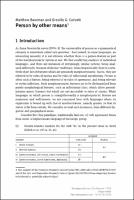Chapter Person by other means
| dc.contributor.author | Baerman, Matthew | |
| dc.contributor.author | Corbett, Greville G. | |
| dc.contributor.editor | Bakker, Dik | |
| dc.contributor.editor | Haspelmath, Martin | |
| dc.date.accessioned | 2019-11-19 23:55 | |
| dc.date.accessioned | 2020-01-07 16:47:06 | |
| dc.date.accessioned | 2020-04-01T09:26:27Z | |
| dc.date.available | 2020-04-01T09:26:27Z | |
| dc.date.issued | 2013 | |
| dc.identifier | 1006439 | |
| dc.identifier | OCN: 1135848315 | en_US |
| dc.identifier.uri | http://library.oapen.org/handle/20.500.12657/23705 | |
| dc.description.abstract | As Anna Siewierska notes (2004: 8) ‘the universality of person as a grammatical category is sometimes called into question.’ And indeed, in some languages, an interesting minority, it is not obvious whether there is a person feature as part of the morphosyntactic system or not. We find conflicting analyses of individual languages, and there are instances of intriguingly similar systems being anal-ysed differently, because of distinct traditions. Cross-linguistically there is a rela-tively short list of features which are genuinely morphosyntactic; that is, they are referred to by rules of syntax and by rules of inflectional morphology. Person is often such a feature, being referred to by rules of agreement, and being relevant to verbal inflection. Such morphosyntactic features are to be distinguished from purely morphological features, such as inflectional class, which allow general-izations across lexemes but which are not accessible to rules of syntax. While languages in which person is straightforwardly a morphosyntactic feature are numerous and well-known, we are concerned here with languages where its expression is bound up with that of another feature, namely gender, so that its status is far from certain. We consider several such instances, from different lin-guistic and geographical areas. | |
| dc.language | English | |
| dc.subject.classification | thema EDItEUR::C Language and Linguistics::CF Linguistics | en_US |
| dc.subject.classification | thema EDItEUR::C Language and Linguistics::CF Linguistics::CFA Philosophy of language | en_US |
| dc.subject.other | Linguistic Typology | |
| dc.subject.other | Person and Pronouns | |
| dc.subject.other | Grammatical Alignment | |
| dc.subject.other | Grammatical Voice | |
| dc.title | Chapter Person by other means | |
| dc.type | chapter | |
| oapen.identifier.doi | 10.1515/9783110331127.1 | |
| oapen.relation.isPublishedBy | 2b386f62-fc18-4108-bcf1-ade3ed4cf2f3 | |
| oapen.relation.isPartOfBook | 68e11b33-3fb7-44cd-8022-61566ffc2937 | |
| oapen.relation.isFundedBy | 7292b17b-f01a-4016-94d3-d7fb5ef9fb79 | |
| oapen.relation.isbn | 9783110331035 | |
| oapen.collection | European Research Council (ERC) | * |
| oapen.collection | EU collection | * |
| oapen.place.publication | Berlin/Boston | |
| oapen.grant.number | 230268 | |
| oapen.grant.acronym | MORPHOLOGY | |
| oapen.identifier.ocn | 1135848315 |

